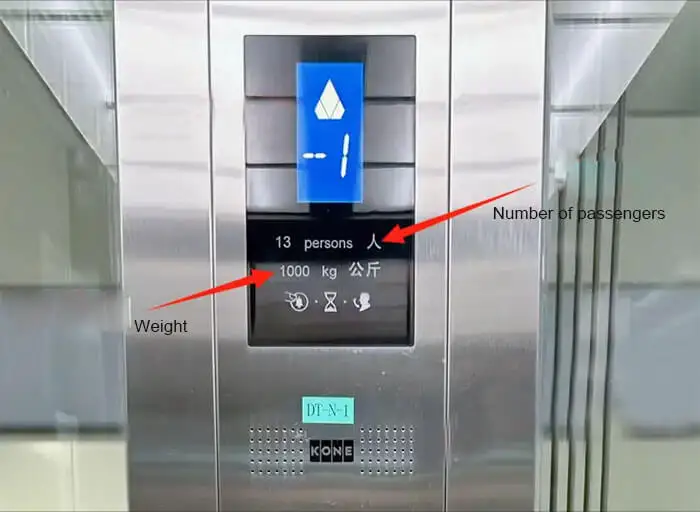Understanding Elevator Weight
When we talk about elevator weight, it basically implies two things:
First, the elevator weight itself – The elevator’s weight includes the car, cables, and support systems. These parts must be calculated by professional engineers. They do this before designing and building any lift. This ensures safety and proper function.
The load weight of the elevator – Most people want to know how much weight it can hold. That can be you, me, or anything from vehicles to hospital beds.
The weight of the elevator structure matters for engineering and installation. But, today, we will focus on load weight. That basically means how much weight an elevator can carry safely.

How Much Weight Can an Elevator Hold
There are various kinds of elevators, each with a different individual maximum load-carrying capacity. Below you can find typical weight ranges for every kind of elevator:
- Commercial Passenger Elevators (1,000–3,500 lbs)
- Home Elevators (550–880 lbs)
- Freight Elevators (2,200–22,000 lbs)
- Car Elevators (6,600–11,000 lbs)
- Hospital Elevators (No less than 3,500 lbs)
1. Commercial Passenger Elevators
A commercial passenger elevator is typically used in office spaces, shopping malls, and apartments. In most cases, these elevators facilitate easy and quick traveling through the respective floors on an everyday basis. Their usual load capacity runs from 1,000 pounds to about 3,500 pounds, which is roughly the equivalent of about four to twenty-one people at a time. These elevators are small and travel quickly. They are perfect for busy places like offices, stores, and hospitals.
2. Home Elevators
Home elevators are popular in many homes today. They are especially useful in houses with two or more floors. They also help those who need better accessibility. Home elevators can carry loads from 550 to 880 pounds and can accommodate 2 to 5 people. They are compact and functional. Their small size makes them great for private use. Home elevators offer enough headroom for a chair-bound person, a couple of people, or a few shopping bags.
3. Hospital Elevators
Hospital elevators are built for medical settings. They prioritize reliability and patient care. Weight capacities vary worldwide in this category. However, to get an idea, we can look at European and American standards EN 81 – 70 and ASME A17.1 respectively.
Both standards suggest a minimum load capacity of 35,000 lbs for hospital elevators. This space is enough to move hospital beds, stretchers, and medical equipment, as well as multiple staff and patients. Hospital elevators ensure smooth, safe, and efficient transport in healthcare facilities, even during emergencies.
4. Freight Elevators
Freight elevators are the large industrial type of elevators. These elevators are designed for heavy-duty jobs. They can lift loads of anywhere from 2,200 to 22,000 lbs. Mostly found in warehouses, factories, and loading docks. They can lift heavy machinery and loads of materials. Freight elevators are built to be durable, resist heavy use, and not fail easily.
5. Car Elevators
Car elevators, as the name implies, are special elevators. They move vehicles up and down between floors. You often find them in luxury parking garages, city homes with limited parking, and car showrooms. Car elevators move different vehicles safely and save valuable ground space. They can handle weights between 6,600 and 11,000 pounds.

Why Understanding Elevator Weight Matters
Remember, sticking to the weight limits isn’t a polite suggestion; it’s mandatory. Therefore, let’s now learn about the elevator weight and why it matters. This will help you avoid any upcoming disasters.
Safety First
Remember, overloading is a serious safety hazard. It can put too much strain on the system. This may lead to sudden stops, jerks, or even serious breakdowns or accidents. Therefore, it is always a good idea to stick within weight limits to avoid any serious accidents and enhance safety.
Optimal Performance
Elevators work best when used within their weight limits. Getting beyond this allows stress on its respective parts, which slows down operation speed and leads to wear and tear.
Durability
An overloaded elevator can set off alarms, and it can cause a halt. Older models are especially prone to mechanical malfunctions if they are overloaded.
Regulations
There are strict building codes relating to elevators. Those include load weight requirements. Violation of those may expose you to fines and even lawsuits.
How to Calculate Elevator Load Weight?
The capacity of an elevator is the maximum weight of passengers and goods that the elevator can safely carry under normal operating conditions. When designing an elevator, engineers will determine the load capacity based on the usage requirements of the building, the expected passenger flow and the type of elevator.
For example, the number of passengers: The capacity is calculated based on the average weight of the passengers (usually 165 lbs) and the space (1.5 square feet per person). For example, an elevator designed for 10 passengers needs a capacity of 1,650 lbs and at least 15 square feet of car space.
If you want to calculate a specific weight for your elevator, please contact Dazen’s engineers for support.
Overloading Consequences at a Glance
If you’ve never overloaded an elevator (good job!). But here’s what generally happens when operators have miscalculations about the requested load:
- The elevator can stop in its tracks and beep loudly.
- For older versions, an overload could cause sudden jolts. The vehicle even drops before emergency brakes kick in. However, it’s a scary scenario, and we believe you don’t want to face it.
- Persistent overloading wears out the machine. So it leads to breakdowns or costly repairs.
Elevator Etiquette for Weight Management
Want to play it safe? You should stick to these quick guidelines, then:
- Always check the weight limit posted inside the cab.
- If the elevator feels packed, wait for the next one—impatience costs more than time.
- Distribute weight in a balanced manner around the car.
- Don’t hold doors open too long. It can disrupt the elevator’s mechanics.
- Remember, your small changes in behavior can make a big difference in the safety and functionality of the elevator.
FAQs (Frequently Asked Questions)
How Is Elevator Weight Capacity Determined?
Factors affecting the weight capacity of an elevator include:
Size, Purpose, Height of the building, Local safety rules
These are the factors that allow knowing the maximum safe load based on mechanical parts and structural design.
Why Do Elevators Have Weight Limits?
Elevators have weight limits for safe, controlled use. Any violation of such limits might increase the risk of mechanical breakdown, which can be dangerous.
What Happens if an Elevator Exceeds Its Weight Limit?
It might refuse to open, could alarm you, or it literally would stop right there. It’s important to note here that modern elevators have a limit which controls overloads and won’t let them operate if the lift is carrying too much weight. However, older elevators can sometimes get too much weight, and when it does so, they drop before the braking system engages.
How Do I Know the Weight Limit of an Elevator?
The weight limit of the elevator are generally posted on the inside of an elevator car somewhere. It’s either placed in conjunction with the control panel or may be shown in both pounds and kilograms in addition to stating the maximum number of passengers.
What Is the Weight Capacity of an Elevator per Person?
Most elevators define their capacity of a particular cabin for about 150-200 pounds (68-91 kg) per person. Yet again, this can vary depending upon a particular model of elevator and the local regulations. Therefore, you should always contact your elevator provider to get the exact information.
Are Freight Elevators Designed to Carry More Weight Than Passenger Elevators?
Yes. Freight elevators typically have more weight than standard passenger elevators. A passenger elevator tends to carry 2,500 to 3,000 pounds. Freight elevators have 10,000 pounds, and in some structures, it can be upgraded.
Can Elevator Weight Limits Be Increased?
Yes, it is possible. But it can be bit costly. When I’m saying this, this usually means replacing large parts, including the car, cables, and motor. So, in these cases, you should replace the entire elevator to increase capacity.
What Is the Weight Limit for a Home Elevator?
Home elevators generally have less load capacity than commercial or public ones. A home elevator usually offers a 550 and 880 lbs (250 to 400 kg) capacity. That is usually enough for 2 to 5 people.
How Much Does an Average Empty Elevator Weigh?
The weight of an empty elevator can depend much on elevator size and purpose. A general elevator will weigh between 1,800-2,700 lbs or 816-1,225 kg. On the contrary, the freight variants can weigh considerably more.
Is It Safe to Carry Heavy Items in an Elevator?
Yes. Elevators especially freight elevators, are generally used for carrying heavy or bulky items. However, just observe the posted weight limits to avoid disruptions.
Who Is Responsible for Enforcing Elevator Weight Limits?
It’s the building manager or owner’s responsibility to make sure that elevators are run safely & within limitations. Common sense should be followed by everyone who sees the posted guidelines. This will help in avoiding unfortunate accidents.
Final Thoughts
Elevators are the best machines that operate safely and effectively. By understanding the weight of an elevator you could be safer. It can also help you to select the safest option.
Do you think of installing a lift in your house, or modernizing the existing systems? Dazen can definitely help customize solutions to match your project’s needs.
Reach out for expert advice and quality elevators. We focus on safety, comfort, and reliability.
